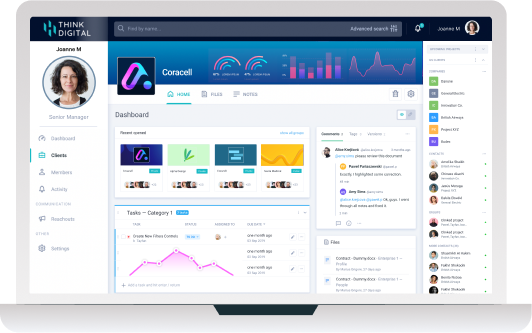Did you know? The first email communication was sent back in 1971, over 50 years ago! Since then, emails have facilitated the vast majority of communication, both in the personal and professional sphere. Statista research suggests that back in 2019, just under 300 billion emails were sent and received every day - this number should increase to over 376 billion by 2025. Unlike most other 50 years old IT innovations, email communication remains the communication channel of choice for most businesses. The intuitive nature of emails and its massive adoption allows anyone to take advantage of quick and easy business communication that can be created, sent, received and understood in seconds. However, the use of email in business comes with its limitations.
Professionals have a long lasting love-hate relationship with email communications
Email communication impacts our productivity in the workplace
Emailing has been described as a hard habit to break - its presence can be felt throughout the workplace and within the very fabric of the daily working method and routine - not always for good. Throughout the years, the ratio of important to unimportant emails in people’s inbox has been getting worse.
Top 3 Stats about email communication (according to TechJury)
1. On average, professionals only respond to 25% of emails in their inbox.
2. Employees check their emails every 37 minutes – that’s 15 times per day
3. 50% of all emails sent are reported as spam
There are a number of reasons that could lead to businesses losing productivity from abusive email use. In particular, one issue of email that can prove to be unnerving is the opportunity to avoid responsibility. Without due maintenance, any email inbox can descend into a cluttered stack of information, making it very easy to miss an important message or update altogether. It’s equally as easy to pretend that this is the case, when questioned, and thereby avoid all accountability. After all, one can’t complete a task that one isn’t aware of. It’s this enabling of the unaccountable culture that can cost businesses untold productivity.
“Reply All” is a blessing and a curse
Email communication continues to fall short when it comes to facilitating information sharing between more than two parties. The dreaded email chain makes working out who the messages are intended for into a guessing game. Add on the fact that every message buries important information deeper into the chain - and you’re quite literally fighting a losing battle.
One interesting study found that emails could inhibit focus and become a drain on productivity as a result. The Danwood group found that it takes on average 64 seconds to ‘recover’ from an interrupting email, regardless of its importance. This effect, when scaled, can have a huge impact over the course of the working day - especially when knowing employees checks their inbox on average 15 times per day.
Email communications aren’t always secure and not everyone knows how to encrypt them
Among the greatest concerns for businesses is security. In particular, the security of their clients or customers’ personal data. To say that email communication lacks the proper security measures for business interactions or file sharing is an understatement - a single stray email containing company information could cause serious harm should it fall into the wrong hands. This is arguably of greater consequence in the case of a client or customer when you consider that the organisation is legally obliged to protect personal data sufficiently.
So how might one address the flaws of email correspondence to attempt to improve business communication and make file sharing safer?
Use email communications together with client portals for more efficient collaboration
What exactly is a client portal?
A client portal, sometimes referred to as a customer portal, is a software that allows for secure interaction between specific parties - historically, clients, business partners and teams. They enable real time collaboration and information sharing between all stakeholders, especially if and while working remote.
Client portals are intuitive, secure & mobile
A client portal addresses most of the pain points created by email communication, including:
- The limitation on file size; typically emails support 25MB attachments (Outlook and Gmail, for example), whereas Clinked offers its users unlimited storage, depending on the package you chose.
- The need for instant messaging; client portals like Clinked come with a mobile app that allows teams and clients to stay connected even on the go. The adoption of smartphones as well as the pandemic has accelerated the transformation of work, and the frontiers between private and professional life have never been thinner. Let your clients, teams and partners connect whenever they want, from wherever they are.
- The need for transparency and accountability; with shared calendars and tasks, client portals allow team leaders and team contributors alike to follow progress in real time. This improved transparency generates trust, accountability and positively impacts productivity and client satisfaction.
Client portals like Clinked are a more secure way to share information with external stakeholders, including clients.
Client portal providers such as Clinked are well aware of the importance of security when sharing information with external stakeholders - especially when the data is sensitive. Clinked offers bank grade security for client files and data. It includes functionalities like two-factor authentication, password protection, extensive permissions and access control, as well as comprehensive audit trail functionalities - just to name a few.
Client portals and email communication should complete each other - not compete
So, what can we learn from this? Emails are here to stay - at least for a little while. However, the adoption of a client portal could enable a business to save valuable working time and protect sensitive data with the appropriate security and compliance measures, all while improving the client experience. While a client portal should be the central location where your client data and interactions live, do not hesitate to complement it with non-confidential email announcements.
When used in tandem with client portals, email communication maximises work time efficiency without altering data security all while offering a great, branded digital experience to your clients.










Let Us Know What You Thought about this Post.
Put your Comment Below.